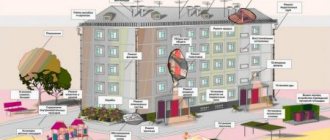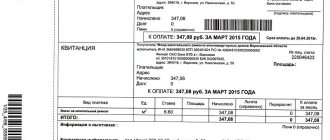Since what year have we been paying for major repairs?
From what month and year do I have to pay for major repairs? Fees for major repairs were officially introduced on January 1, 2014. And until August 1, 2015, residents of apartment buildings had to decide how to raise funds for future repairs. Or allow local authorities to manage funds through a regional capital repair operator, transferring money to a special fund. Or, based on the decision of the general meeting of residents of the house, open a special bank account where all the money is personally transferred.
True, in both cases, the decision on when and in what time frame to repair the house will be made by the local administration. However, there is still a plus in a special account: you know for sure that your funds will not be repaired to another house or misused for other utility needs. In the case of a “common pot”, it will be difficult to track the expenditure of your money.
But don’t be upset if you didn’t manage to open such a special account for fees for major repairs when fees for major repairs were introduced. You can do this at any time. To do this you need to follow a certain order.
It is necessary to hold a general meeting of apartment building owners, make several decisions and determine:
- the amount of the monthly contribution for major repairs. Its amount must be greater than or equal to that established by local authorities as the minimum.
- what kind of repair work will be carried out in your home. This list should contain no fewer items than the list of the regional capital repair fund.
- timing of repairs. It must also pass no later than what the local authorities have established in their program.
- the owner of this special account.
- the bank where the account will be serviced.
After all these procedures, within five days after adoption, this decision must be brought to the attention of the regional operator of the overhaul fund, where all your funds are being transferred for now. Then you will have to wait six months for the decision to come into force. And after this period, the local operator will transfer the funds collected by your home to a special account.
An entry in the Unified State Register about the owner of the property is proof of ownership of it
The court of first instance based its decision on a current extract from the Unified State Register of Real Estate, where the city administration was listed as the owner of non-residential premises. According to Part 3 of Art. 158 of the Housing Code of the Russian Federation, the obligation to pay the costs of major home repairs applies to all owners of premises from the moment the ownership of such premises arises.
In its defense, the municipality provided the court with copies of the conclusion of the district commission and an extract from the order that the disputed premises were excluded from the register of municipal property as belonging to the common property of residents in the apartment building. But the court indicated that the exclusion of premises from such a register if there is a registered right in the Unified State Register of Real Estate has no legal significance.
State registration of rights to real estate in the Unified State Register of Real Estate is a legal act; it recognizes and confirms that a person has acquired, changed, transferred, or terminated rights to real estate. This is the only evidence of the existence of a registered right.
Challenging such a right to real estate occurs in court: decisions on claims are the basis for making an entry in the Unified State Register of Real Estate. But the defendant did not take such actions, and no changes were made to the register.
A municipality is liable for its obligations with the property it owns and is obliged to bear the costs of its maintenance by force of law (Articles 126, 210 of the Civil Code of the Russian Federation).
The court of first instance satisfied the claim of the Capital Repair Fund, adjusting the amount of the penalty to the amount of the debt. The Court of Appeal, where the municipality appealed, did not add anything new to the decision of its colleagues, leaving it in force.
Homeowners' association experience: how the chairman brought order to a neglected hostel
How long does it take to pay for major repairs in a new home?
Most of all, the introduction of fees for major repairs caused anger among residents of new buildings. And they can be understood. After all, a reasonable question arises: why repair something that has just been built?
On this score, the government, after long discussions, finally decided to introduce a tax holiday for those houses that were or will be commissioned after the federal program was put into effect.
From what date do they pay for major repairs in new buildings? If your home was sold after the start of the federal program, then you have the right to a payment holiday of three to five years.
A more precise period will be determined by the region in which you live, but it cannot be less than three years. Nothing will be credited during this period.
Tariffs in different regions
Of course, even those who are not paying soon are worried about the question: how much will they actually have to deduct?
Each region sets the minimum contribution amount independently until October 1 of the year preceding the next three-year period. On average, homeowners pay 6-7 rubles per square meter. In the Leningrad region, they generally collect only 2 rubles per square meter, but in Moscow this amount is 15 rubles.
What area is the fee for major repairs charged? The fee is calculated based on the total area of the apartment. For example, if you have a house of 50 square meters, and you live in the capital, you will see an amount of 750 rubles on the receipt if you are not entitled to benefits.
When they started paying for major repairs, who should do it? The fee is charged only to owners of privatized apartments (read more about whether residents of privatized and non-privatized apartments need to pay). If the home is state-owned, then the person living there under a social tenancy agreement does not pay anything. Read about in what cases you can refuse to pay, and who has the right not to pay contributions, you can find out here.
Find out more information about paying contributions for major repairs. Read about how to pay contributions through Sberbank and Sberbank-online, as well as how to find out the debt and what benefits there are for paying for major repairs.
Until the house collapsed
15 rubles per square
The capital approved a regional program for capital repairs of multi-apartment residential buildings on New Year's Eve, one of the last in the country. And not because this issue is of secondary importance for her, it’s just that Moscow’s housing stock is very large - 243 million square meters. m. More than anyone else in Russia!
Until now, the city authorities have tried to put it in order, as Artur Keskinov, head of the housing overhaul department, told RG, using budget money. Over the last 4 years alone, more than 86 billion rubles have been spent. With this money, individual engineering systems were repaired in 10 thousand houses, and facades were repaired in 1 thousand houses located in the center of Moscow and along outbound highways. The elevator facilities were partially updated. As a result, the shortage of repairs in the city decreased by six times. But nevertheless, even now experts estimate it at 173 billion rubles. The engineering systems alone are in unsatisfactory condition - 72 thousand out of 325 thousand available in the city. If we continue to carry out repairs at the same pace, relying only on the budget, then by 2023 almost half of the engineering systems will be in disrepair.
There is only one way out - to attract funds from residents for major repairs. Moreover, 80% of apartments in Moscow have been privatized. And the federal law obliged local authorities to determine the amount of payments for the population no later than the end of 2014.
For guidance, the Russian government has determined federal standards for all regions. For Moscow this is 7.7 rubles per sq. m. m. But the law does not oblige you to adhere to this figure. Each subject has the right to set its own tariffs based on the state of the housing stock. As Moscow City Duma deputy Stepan Orlov said, during a discussion in the Public Chamber, experts initially assured that high-quality repairs could not be done for less than 50 rubles per square meter per month. However, these statements were regarded as irresponsible. And by the time the draft law was submitted to the Moscow City Duma, they agreed that an adequate fee to actually cover the housing needs for repairs was 23-25 rubles per square meter. “But taking into account modern technologies and modern materials, which will extend the time between repairs, we settled on 18 rubles per sq. m. meter,” said Stepan Orlov. “This is the minimum reasonable price.”
According to Moscow Mayor Sergei Sobyanin, this price is too high. “Moscow has accumulated extensive experience in saving money on construction, reconstruction and major repairs. As a rule, the reduction in these prices reaches 20-25% at all stages of planning,” he said. And taking all this into account, he proposed reducing the minimum payment by 20% - to 15 rubles per sq. m. m per month. Let's do the math. It turns out that a family with a one-room apartment with an area of 33 square meters. meter, major repairs will cost 495 rubles, and for those who have three rubles - 1050 rubles. per month.
Arthur Keskinov admitted that such optimization of the program is possible. Thus, if the city is now spending approximately 17 billion rubles on major housing repairs. per year, then another 30 billion will be sent with contributions from Muscovites. Low-income Muscovites, the mayor emphasized, should not suffer. To do this, he proposed to provide discounts on contributions for major repairs to everyone who uses them to pay for the entire utility bill. That is, WWII veterans, labor veterans and a number of other categories. These benefits will be paid according to the same principle: if the cost of housing, including major repairs, exceeds 10% - the family income threshold, it will receive a subsidy from the city. According to city authorities, there are 2.5 million such people in Moscow.
Let me remind you that in December last year the Moscow City Duma adopted a law establishing the timing of the first payments of contributions for major repairs 6 months after the adoption by the government of the capital of the regional capital repair program. Consequently, Muscovites will see the first payments for major repairs in their July 2015 payment invoice.
What will be repaired and when?
A specific list of work that must be carried out during the overhaul is approved by the federal program. This includes repairing roofs, facades, basements, foundations, putting in order all the building's engineering systems - water supply, sewerage, replacing elevators. The capital also decided to include repairs to fire extinguishing and smoke removal systems and elevators. There was an idea to add energy saving work, but, judging that this would increase the cost for Muscovites to an unaffordable level, they decided to do it at the expense of investors. The city has such experience and, as they say in the Department of Fuel and Energy, it is quite successful.
In total, the regional capital renovation program for houses in the capital includes 31,590 houses and 325 thousand engineering systems. The specificity of the capital is that this program has been formed for 30 years - from 2015 to 2044 on a three-year cycle. So any Muscovite will soon be able to see on the Moscow government website which specific three-year plan his house falls into. The distribution by year depends on the construction of the house, the timing of previous repairs and the service life of the existing engineering systems in the house. Despite the scale of the housing stock, it was not difficult to draw up such a schedule, said Arthur Keskinov, since the capital’s housing inspectorate regularly conducts technical monitoring of the condition of housing in the city. Based on the data from this monitoring, a list of houses that the city intends to put in order first will appear in the near future. According to Arthur Keskinov, these are the houses whose condition is now the worst. These include five-story buildings, houses built before the war and the first period of panel housing construction.
Who to trust?
Before July, when the payment slip arrives with the amount of the first payment indicated on it, Muscovites need to decide who they will entrust their money for repairs and the repairs themselves. There are two options. The first is to pay into the general city Capital Repair Fund, which will be formed in the near future. It will accumulate all the funds of the townspeople and, as the deadline specified in the program arrives, repair house by house. According to Arthur Keskinov, there is no need to worry about the safety of these funds, since according to federal law these funds cannot be spent on anything else.
Option two. If the residents of the house want to manage this money themselves and find a contractor themselves and control the quality of his work, no one forbids them from doing so. To do this, they need to open a special bank account by decision of the general meeting. And then, if they deem it necessary, it will be possible to repair their house even earlier than planned in the program. And carry it out on a much larger scale if you are willing to pay for it yourself. But not less than is necessary in accordance with the federal list. The Control and Accounts Chamber of the city of Moscow will monitor the expenditure of both these funds and the funds of the city Capital Repair Fund.
By the way
In Moscow, the capital repair rate is 3.8% of the payment for residential premises and utilities of Muscovites. This is one of the lowest rates in Russia. In the first three years alone from the start of work in capitally renovated houses, it is planned to repair 3 thousand houses in the capital and replace 30 thousand engineering systems.
Lifetime fee
The federal overhaul program will operate for thirty years. In the Moscow program, all repair periods for each house are divided into three years. After this period, the program may be adjusted.
From what time do they pay for major repairs? The timing and duration of repairs for each house are determined individually by the program, based on the technical condition of the engineering systems and the duration of operation.
Even if your old home has recently been extensively renovated, you will still continue to contribute to the next renovation, even if it is ten to twenty years from now.
Now you know from what month they pay for major repairs. It cannot be said that such fees are an innovation in recent years. In Soviet times, such payments also existed, they were simply included in the total cost of utilities. At that time there was no private property, so all care for the condition of the house lay on the shoulders of the state. Now that apartments have become privatized, their owners must bear responsibility to a greater extent for the comfort of the house in which they live.
On a note
Case No. A53-15079/2020 has not yet been completed: a trial court hearing has been scheduled for July. But already now we can draw several important conclusions for the management company, homeowners associations and owners of premises in apartment buildings:
- The right of common shared ownership of the common property of an apartment building arises by force of law, regardless of its registration in the Unified State Register of Real Estate.
- The premises are included in the general property of the house if it meets the characteristics of such property, for example, it is intended for maintenance or use by residents of more than one apartment in an apartment building.
If the house has such premises, but they are registered with the municipality, the homeowners have the right to contact the local government. The municipality considers the appeal and, by decision of the commission, excludes these areas from the register of its property. If the city authorities refuse to do this, the owner has the right to go to court and prove that the premises are common property.






